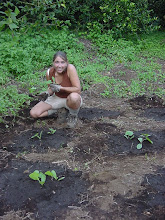Cultural friction, financial struggles, and a load of personal griefs eventually snowballed from challenging to uncomfortable to unacceptable.
With a heavy heart I packed up my brand new beautiful casita, stored away my garden tools, and hardest of all relocated my farm animal friends.
Sweet Lupita is now living on a goat dairy farm, surrounded by lots of girlie goat friends and will be expecting her own kids one of these days.
Luckily, we still keep track of Lucinda, who is living amongst a new herd at La Mariposa Eco-Hotel with Paulette and friends!
We all had a hard time saying goodbye to Daisy, though it might be Stella who suffers the most from missing her sister pup. Daisy is still in the family where she is top dog, gets loads of attention, and visits the farm every day!
Stella and Chia made the trek with us and are learning to transition from fancy farm free to domestic pets.
Life ain't always easy, as Chia learned the hard way; he lost a front leg since our move and is now a local tripod celebrity :)
*Our home will be available as a vacation rental if anyone is craving a tropical getaway on an organic coffee farm with scores of fresh lemons, oranges, mangoes, and guavas to eat. Be prepared to bike pump your water and take showers when the sun is high, fall asleep to a magnificent cricket chorus, and awaken at dawn to cheery birdsong. Send me a note if you or a friend are interested!*
Meanwhile, we are settling in to a USA life again, in a little town called Santa Fe where Spanish is more than a second language and tacos are sold on every corner. From here I hope to continue garden experiments, and maybe even blog about them. Thanks for coming along on the ride so far....
















































